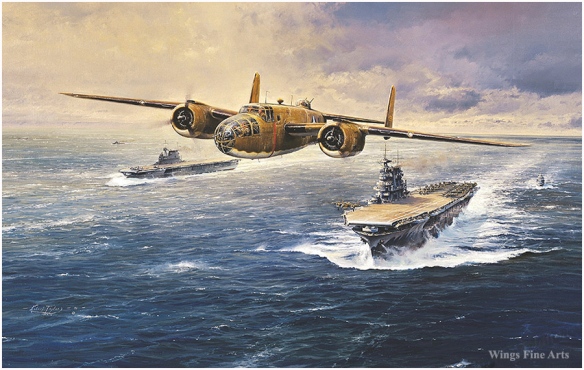The Doolittle Tokyo Raiders by Robert Taylor depicts the morning of April 18th, 1942, just 4 months following the devastating surprise attack on Pearl Harbor, 16 Army Airforce B-25 Bombers, under the command of Lt. Col. James Doolittle, engaged in a daring aerial raid to strike back at the enemy’s capital of Tokyo.For his role, Doolittle was awarded the Congressional Medal of Honor.
The Doolittle Raiders by Robert Taylor
On April 18, 1942, with the Japanese victorious on every front, Lieutenant Colonel James H. “Jimmy” Doolittle of U.S. Army Air Forces (USAAF), led 16 B-25 Mitchell bombers from the deck of the aircraft carrier Hornet on a daring—well-nigh suicidal— bombing raid against Tokyo and other Japanese cities. The pilots knew that they could not deliver enough bombs on their targets to cause anything approaching strategically significant damage. However, in the wake of the Battle of Pearl Harbor and other American and British defeats, Doolittle and his raiders wanted to carry out a mission that would generally raise American and Allied morale, that would depress the morale of the Japanese, and that would force the Japanese to keep a large number of aircraft on patrol over the home islands rather than in combat. Doolittle and his men also knew that, difficult as it was to launch twin-engine medium bombers from the deck of an aircraft carrier, it was impossible to land them there again, and they could not carry sufficient fuel to fly to a friendly base. After the raid, they would have to land in China and hope for the best in their efforts to escape and evade capture and return home.
The origin of the Doolittle raid is obscure. Official early USAAF histories credited President Franklin D. Roosevelt with the idea, but U.S. Fleet Commander Adm. Ernest J. King said that he first heard of it as an off-handed remark from his operations officer, who observed that it was possible to launch twin-engine bombers from an aircraft carrier, a prospect that made an early air attack on Japan feasible, albeit just barely. Enthusiastic about the idea, King conferred with USAAF chief General Henry H. (“Hap”) Arnold, who also greeted it with enthusiasm. Arnold chose Doolittle, a great pilot with formal training in aerodynamics, to organize and lead an air group to execute the mission. Doolittle decided on using the B-25B Mitchell medium bomber, which was both modern and combat proven. Quick tests proved that it could indeed be launched from a carrier while hauling a militarily useful bomb load and sufficient fuel to strike Tokyo, then continue to airstrips in China. Once Doolittle had established to his satisfaction the technical feasibility of the mission, he set about recruiting volunteers for a top secret mission he could not at the time explain, other than to warn each prospect that it was highly dangerous. After gathering pilots and crews for 16 planes, Doolittle led a special training program for his men and oversaw necessary modifications to their aircraft.
The Hornet, newly launched, would carry the planes, but the mission was so secret that the carrier’s skipper, Captain Marc Mitscher, was not briefed until just before the aircraft were loaded onto the flight deck. On April 2, 1942, the Hornet sailed and was joined en route by the carrier Enterprise, Vice Admiral William “Bull” Halsey’s flagship, on April 13. The Enterprise would provide air cover during the approach to the launching point, which was scheduled to be reached on April 18. This position was about 400 miles off the Japanese mainland. Shortly before dawn on the 18th, however, enemy picket boats were sighted much farther east than expected. Although the U.S. ships either evaded or sank the enemy craft, they had been able to transmit radio warnings. With the element of surprise hanging in the balance, Doolittle decided to launch his raid immediately, not 400 miles off the coast, but 700, which would strain fuel supply even more and quite probably prevent at least some of the aircraft from finding relatively safe haven in China.
The raiders took off, all successfully, about 8 a.m., 16 five-man crews in all. One bomber attacked Kobe, another Nagoya, and a third, slated to bomb Osaka, instead dropped its ordnance on the Yokosuka naval yard and on Yokohama. A fourth plane was forced to divert to a landing at Vladivostok. The 12 other raiders bombed Tokyo at noon. As chance would have it, the Japanese were conducting a drill, a mock air raid, at the time. This probably diluted the psychological effect of the raid, but it also provided a diversion that helped the bombers escape. No bomber was lost over Japan.
Damage inflicted was modest. Some 50 people were killed and 100 houses damaged or destroyed. The damage to the prestige and air of invulnerability that had surrounded the Japanese militarists was much more severe. Another effect of the raid was to remove official objections to the plan proposed by Admiral Yamamoto Isoruku to draw out the American fleet to the area of Midway Island and deliver a fatal blow there. In fact, the Battle of Midway would result in an American victory that turned the tide of the war in the Pacific.
After the raid, the bombers, now critically short of fuel, either crash landed in China or were abandoned, their crews bailing out. Almost miraculously, Doolittle and 70 other mission members survived, all eventually finding their way back home. One airman was killed in parachuting from his plane, and eight were captured by the Japanese. Of this number, three were executed and one died in prison.
Further reading: Doolittle, James, with Carroll V. Glines. I Could Never Be So Lucky Again: An Autobiography. New York: Bantam, 2001; Glines, Carroll V. The Doolittle Raid. Atglen, Pa.: Schiffer, 2000; Lawson, Ted W. Thirty Seconds over Tokyo. London and New York: Brassey’s, 2003; Nelson, Craig. The First Heroes: The Extraordinary Story of the Doolittle Raid—America’s First World War II Victory. New York: Viking. 2002.
